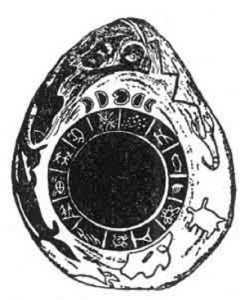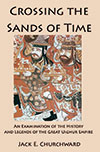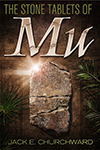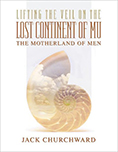Continuing the research on the artifact shown on page 230 of the 1932 Sacred Symbols of Mu, my web search yielded 2 links. One was to a New York Times article, reprinted in the July 1, 1933 Arkansas Catholic and discussed in this previous posting. The other to the Manataka Indian Council and an email link to Lee Standing Bear Moore with more information on the stone, that Mr. Moore calls the “Manataka Stone.”

From Sacred Symbols of Mu
A Mound Builder’s Calendar Stone Found in the Ouachita River, Hot Springs, Arkansas
From Col. J. R. Fordyce, Little Rock, Arkansas
This posting covers the information gained from Lee Standing Bear and the Manataka Indian Council.
From his email:
The book, “Sacred Symbols of Mu” is largely discounted by the Department of the Interior, Hot Springs National Park Service.
The NPS refers to the object as the “Calendar Stone”
The Manataka Stone was discovered inside one of the ceremonial caves on the sacred Manataka mountain. It was kept by a private individual for several years until it was taken to the ‘government house’ here at Hot Springs where it was frequently used as a doorstop by the federal agent in residence. A study was done by a professor from Boston circa 1921, who made a dark pencil etching of the actual stone and the picture of the stone is a copy of that etching. Immediately after the report was completed the Calendar Stone disappeared. Presumably, the stone was taken to the Smithsonian Institute in Washington, D.C.
However, the Smithsonian and the Department of the Interior say the location of the Calendar Stone is not known and it was a phony dreamed up by the author of Sacred Symbols of Mu who copied information from Col. John Rison Fordyce. We know this is true because of a report written by Colonel John Rison Fordyce (1869-1939) sometime in the early 1930’s. Col. Fordyce obviously personally measured the stone. See Attached “Manataka Calendar Stone”
Col. Fordyce’s biography: http://www.encyclopediaofarkansas.net/encyclopedia/entry-detail.aspx?entryID=3186
You will find that Col. Fordyce’s report contains references to “Mu”. This report is most likely the source for your grandfather’s assumption that the Calendar Stone came from “Mu”. Col. Fordyce was a promoter of sorts and often engaged in fanciful descriptions about Hot Springs history and indigenous artifacts inherited from his father and grandfather, Samuel Fordyce. Therefore, your g-grandfather copied the Fordyce report – a report that was not correct in its descriptions of the thirteen glyphs found on the stone. For some reason, Fordyce also alleged that the stone had been recovered from the Ouachita River where it had been for several centuries. We know this is not correct because the stone is made from sandstone, and sandstone quickly disintegrates in water.
Quotes from the Manataka website
“The southern-most cave, nearest the surface of the ground, once held the Manataka Stone, or as referred to by the National Park Service as the ” Calendar Stone” brought by people from the south. Workmen digging on the mountain to capture the sacred waters of Nowasalon for the ornate bathhouses of the rich removed the Calendar Stone after the Civil War.”http://www.manataka.org/page352.html
“The southern-most cave, nearest the surface of the ground, once held the Manataka Stone, or as referred to by the National Park Service as the “Calendar Stone” brought by people from the south. The Calendar Stone was removed after the Civil War by workmen digging on the mountain to capture the sacred waters of Nowasalon and build ornate bathhouses for the rich.” http://manataka.org/page2.html
Our Understanding
We were informed by a group of Mayan elders who visited Manataka in 2003 that the calendar stone came from their ancestors, the Tula. The Tula were also the ancestors of the Toltec residing approximately 65 miles NW of present day Mexico City. The Tula people sent a large group to Manataka long ago and they established a village called Tanico located at today’s Caddo Gap in the Ouachita Mountains about 45 miles NW of present day Hot Springs, AR. Interesting enough, the same sandstone material used to create the stone is abundant at Gaddo Gap.
The Maya priests also informed Manataka’s Elders about the symbols that appear on the Calendar Stone. (Much different from those described by Fordyce.)
Today, we are the keepers the true meanings of those symbols shown on the Manataka Stone.
We do not know of any more authoritative information available about the Manataka Stone aside from the Elders of Manataka.
One thing we do know is the Manataka Stone, the Calendar Stone and the stone pictured in “Sacred Symbols of Mu” are obvious the same object, but none of them were from the Washitaw people. Your g-grandfather somehow made a wild assumption about its origin without any hard evidence other than the Fordyce report that was erroneous.
The contents of the attachment matched the contents of Sacred Symbols of Mu beginning on page 230 and reprinted in a previous posting. My reply to his correspondence included a request to publish the real meanings of the symbols on the stone, his response:
These people promoting the Washitaw de Dugdahmoundyah must not be concerned about accuracy. We heard sometime back that the title of their group was taken from a story that was a joke – Dug-Dah-Mound-Yah. Sounds like a rap song.
The real meanings of some of the symbols engraved on the stone cannot be revealed to anyone outside the Elders of Manataka. We searched for over twenty-five years for that information and when I was about ready to give up, the Mayan Elders appeared here at Manataka and resolved many of our questions about their meanings. There still remains a number of questions about the meanings of the symbols, but the biggest open question is about the star map in the middle of the circle surrounded by the symbols. We can say with some certainty that Fordyce’s interpretations were nearly 90% incorrect and he completely overlooked largest most meaningful depiction, the star map, in his interpretation.
Further information about the Manataka Indian Council can be found on their website or in this article entitled, “DID ANCIENT STAR PEOPLE COME TO MANATAKA AND DEPOSIT WISDOM OF THE COSMOS IN A SECRET CRYSTAL CAVE?”
It would only be fair to follow up the National Park Service, so stay tuned for the next installment where we cover their response to my email and sources that actually have seen the artifact.
Have a great day.









 RSS - Posts
RSS - Posts